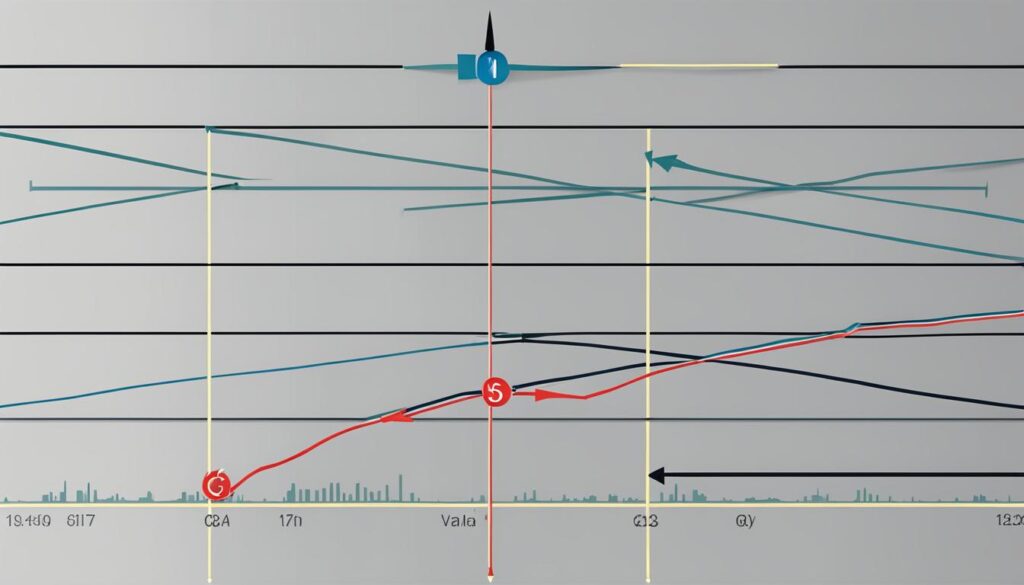Capital gains taxes can significantly reduce investment earnings unless actively managed through strategies such as holding investments long-term and utilizing tax-deferred accounts. In order to maximize investment returns, investors need to approach the concept of deferring taxes on capital gains by employing a variety of tactics based on their unique circumstances.
By understanding the different capital gains tax deferral techniques available and the tax rules that govern them, individuals can make more informed decisions about their portfolios and long-term financial goals.
Understanding Capital Gains and Their Impact on Investments
Capital gains result from the profitable sale of assets or investments, attracting capital gains tax notably at the federal level. These gains can significantly impact an investor’s overall financial portfolio, as they are subject to varying tax rates, depending on the individual’s total annual income and the nature of the gain, classified as either short-term or long-term.
Proper understanding and management of capital gains are essential for minimizing tax impact and optimizing investment portfolios. By exploring different capital gains tax options, investors can adopt strategies aimed at preserving their investment gains without incurring unnecessary tax burdens. This involves thorough tax planning for capital gains to ensure the maximization of investment returns.
Short-term capital gains arise when an investor sells an asset held for less than one year, whereas long-term capital gains stem from assets held for more than a year before being sold. The tax rates applied to these gains differ significantly and have a notable influence on an individual’s investment strategy.
As tax laws and regulations may change over time and considering the complexities associated with the taxation of capital gains, it becomes crucial for investors to stay informed of current rules and adapt their tax planning strategies accordingly. This can ultimately lead to more tax-efficient portfolios and potentially higher long-term returns for investors.
The Difference Between Short-Term and Long-Term Capital Gains

When it comes to capital gains taxation, there are distinct differences between short-term and long-term gains. Understanding these differences not only aids investors in making informed decisions but also helps them leverage the tax advantages associated with holding periods.
The Tax Implications of Holding Periods
Capital gains are generally classified into two categories: short-term and long-term. Short-term capital gains arise from the sale of assets held for less than a year, while long-term capital gains result from the sale of assets held for more than a year. The holding period plays a crucial role in determining the tax implications on these gains.
Short-term capital gains are subject to regular income tax rates, which can be as high as 37% depending on the individual’s taxable income. On the other hand, long-term capital gains benefit from more favorable tax treatment, with rates generally not exceeding 15%. However, some specific assets may attract special rates ranging up to 28%.
Given the significant impact of holding periods on capital gains taxes, investors should pay close attention to the duration for which assets are held before selling.
Long-Term vs. Short-Term Rates: What’s More Beneficial?
As evident from their respective tax rates, long-term capital gains offer more financial benefits when compared to short-term capital gains. Investors with long-term capital gains may enjoy lower tax rates, and in some cases, qualify for rates as low as 0%. These lower rates make a compelling case for favoring a buy-and-hold strategy for investments.
The tax advantages of capital gains deferral further emphasize the importance of holding investments for over a year before selling, allowing investors to tap into the more favorable long-term capital gains tax rates. By doing so, investors can minimize their tax liabilities and maximize their overall investment returns.
In conclusion, understanding the differences between short-term and long-term capital gains, along with their respective tax rates, can significantly influence an investor’s financial decision-making process. By leveraging the benefits of long-term capital gains, investors can optimize their investment strategies and accumulate substantial wealth over time.
The Role of Tax-Deferred Accounts in Capital Gains Management

Tax-deferred accounts play a significant role in the management of capital gains by providing investors with opportunities to invest without immediate tax liability. These types of accounts, a crucial component of robust tax deferral strategies, can help investors save and grow their wealth more efficiently. Tax-deferred accounts enable investments to compound over time, allowing for the potential accumulation of larger sums in the long run.
Money within tax-deferred accounts, a vital tool to assist with capital gains management, grows over time, potentially leading to significant tax benefits. Taxes are only levied upon withdrawal, generally at the ordinary income rate instead of capital gains rates. Not having to pay taxes on investment gains as they occur can lead to faster accumulation of wealth, enabling investors to reach their financial goals more quickly.
There are various types of tax-deferred accounts available to investors, each offering different advantages and suitability based on individual financial situations and goals. Some popular options include traditional Individual Retirement Accounts (IRAs), employer-sponsored 401(k) plans, and annuities. It is essential to understand the differences between these accounts and evaluate which options align best with your investment strategy and objectives.
Investors should be aware of potential drawbacks associated with tax-deferred accounts. While these accounts offer the advantage of deferring taxes on capital gains, they may also impose restrictions on withdrawals. Early withdrawals, usually before the age of 59½, may incur penalties alongside taxes. Therefore, understanding the rules and requirements of these accounts is crucial when incorporating them into your capital gains management strategy.
In summary, tax-deferred accounts are an essential component of effective tax deferral strategies and capital gains management. Utilizing these accounts can potentially yield more significant investment returns by deferring taxes, ultimately empowering investors to reach their financial goals more efficiently.
How Retirement Accounts Can Shield You from Capital Gains Taxes

One of the most effective ways to protect your investment earnings from capital gains taxes is to utilize retirement accounts that offer tax-deferral benefits. Such accounts include the 401(k) and traditional IRAs, which not only shield investors from immediate capital gains taxes but also provide upfront tax deductions on contributions.
Utilizing 401(k)s and Traditional IRAs for Tax Deferral
By contributing to a 401(k) or traditional IRA, investors can enjoy the benefits of tax-deferral on their investments. The money in these accounts grows over time without being subject to immediate capital gains taxes. Instead, taxes are levied upon withdrawal, and they are generally charged at ordinary income rates, which may differ from capital gains rates.
With a 401(k), many employers offer matching contributions, further enhancing the tax-deferral benefits and maximizing your investment growth potential. On the other hand, traditional IRAs can be initiated and maintained by the individual investor, providing a more flexible approach to retirement savings and capital gains tax deferral.
It’s worth noting that early withdrawals from these accounts may result in penalties in addition to the ordinary income taxes. As such, it is crucial to plan accordingly and prioritize long-term investment goals when utilizing these retirement accounts for tax deferral purposes.
In conclusion, retirement accounts such as 401(k)s and traditional IRAs provide an effective shield from capital gains taxes while setting investors up for financial success later in life. By utilizing these tax-deferred accounts, long-term investment growth can be maximized, and overall tax liability can be significantly reduced.
Exploring Tax-Exempt Accounts like Roth IRAs

Investors seeking more flexibility when it comes to managing capital gains taxes should consider tax-exempt accounts like Roth IRAs. Although contributions to Roth IRAs are made with after-tax dollars, they offer significant future benefits that can lead to substantial tax savings in the long run.
One of the most significant advantages of Roth IRAs is the tax-free growth of investments held within the account. All earnings, whether from interest, dividends, or capital gains, remain untaxed as long as the assets remain in the account. This allows investors to maximize their returns without the burden of capital gains taxes on the account’s growth.
Additionally, qualified withdrawals from a Roth IRA during retirement are completely tax-free. This includes both contributions and earnings, allowing investors to access their retirement savings without incurring additional taxes. In contrast, withdrawals from traditional IRAs and 401(k)s are taxed as ordinary income, potentially subjecting investors to higher taxes during retirement.
It’s essential to note that there are eligibility requirements and contribution limits for Roth IRAs. These factors can vary depending on your income and age, making it crucial to discuss your specific situation with a financial advisor or tax professional to determine if a Roth IRA is an appropriate retirement savings vehicle for you.
In conclusion, tax-exempt accounts like Roth IRAs are a powerful tool for investors seeking to minimize capital gains taxes and maximize long-term financial growth. By offering tax-free growth and tax-free withdrawals in retirement, Roth IRAs effectively negate the impact of capital gains taxes and allow investors to enjoy the fruits of their investments without the tax burden typically associated with capital gains.
Strategic Asset Allocation and Tax-Loss Harvesting

Effective investment tax planning includes a blend of strategic asset allocation and tax-loss harvesting to minimize capital gains taxes. These methods can help investors strike a balance between risk and return, while ensuring they only pay taxes on net profits.
Strategic asset allocation aims to create a diversified portfolio that remains resilient to market fluctuations. By distributing investments across various asset classes like stocks, bonds, and real estate, investors can manage risk and potentially reduce their tax liabilities.
Pairing Gains with Losses to Minimize Taxes
Tax-loss harvesting is a powerful technique that involves selling underperforming assets to realize a loss, which then offsets capital gains made from other investments. Pairing gains with losses helps reduce taxable income, and only the net profit will be subjected to capital gains taxes. This approach can significantly lessen overall capital gains tax liabilities and improve after-tax returns.
By carrying over excess losses, investors can continue to offset future gains and further minimize capital gains taxes. Tax-loss harvesting allows for more efficient management of investment portfolios and smarter tax planning.
In conclusion, combining strategic asset allocation with tax-loss harvesting enables investors to optimize their portfolios for both tax efficiency and long-term growth. By pairing gains with losses and carrying over excess losses to offset future gains, investors can minimize their overall capital gains tax liabilities and maximize their investment returns.
The Importance of Timing When Selling Assets

One key aspect in minimizing capital gains taxes is the timing of selling assets. Strategically deciding when to realize gains or losses can make a noticeable difference in your tax liability, allowing you to make the most of your investments.
Year-End Planning for Maximizing Tax Benefits
Year-end tax planning is a crucial step in optimizing your tax benefits. By analyzing your financial situation towards the end of the fiscal year, you can identify opportunities to align your capital gains or losses with your tax status. For instance, if you have already incurred substantial short-term capital gains during the year, it may be more advantageous to delay selling additional assets with short-term gains until the following year, in order to manage your tax bracket and reduce your overall tax expenses.
Similarly, if you have realized significant capital losses, you might choose to sell some of your profitable assets before year-end, as this would offset the recognized gains and minimize your capital gains tax liability. Furthermore, this approach can also help you to carry forward any unused capital losses into the next tax year, providing you with a valuable tool for future tax planning.
In conclusion, the timing of selling assets plays a vital role in managing capital gains taxes. By engaging in year-end tax planning and carefully considering when to realize gains or losses, you can maximize tax benefits, ultimately enhancing the growth of your portfolio.
Charitable Contributions as a Method for Reducing Taxable Gains

Charitable contributions offer a valuable option for investors seeking to reduce their taxable gains while simultaneously supporting a great cause. By donating appreciated assets to eligible charities, individuals can potentially lower their capital gains tax burden and claim a tax deduction for the contributed asset’s fair market value.
When investors donate assets like stocks or property that have appreciated in value, they avoid incurring capital gains taxes typically levied upon the sale of these assets. Additionally, by claiming a tax deduction for the fair market value of the donated items, they can further reduce their taxable income. The result is a significant lowering of their overall tax liability.
However, it’s crucial to remember that not all contributions qualify for tax deductions. To ensure that a charitable donation is tax-deductible, verify that the recipient organization has tax-exempt status under section 501(c)(3) of the Internal Revenue Code. Further, the amount deductible may be limited depending on the donor’s adjusted gross income (AGI) and the asset type donated.
In a nutshell, charitable contributions represent a powerful method of reducing taxable gains while promoting philanthropy. Leveraging this strategy, investors can optimize their tax situation and support worthwhile causes simultaneously.
Utilizing 1031 Exchanges for Real Estate Investments

One effective strategy for deferring capital gains taxes on real estate investments is the use of 1031 exchanges. This tax-deferral technique allows investors to reinvest proceeds from a property sale into a new investment, postponing the capital gains taxes that would otherwise be due upon sale.
Reinvesting Proceeds to Postpone Taxes
Under Section 1031 of the Internal Revenue Code, investors can exchange like-kind properties while deferring the taxes on their capital gains. In order to qualify for a 1031 exchange, investors must adhere to specific guidelines and timeframes.
The properties involved in the exchange should be of like-kind, meaning they should be similar in nature or character, regardless of their difference in quality or value. For example, exchanging an apartment building with an office building could qualify as a like-kind exchange.
Another important aspect of 1031 exchanges is that investors must identify a replacement property within 45 days of selling the relinquished property and complete the exchange by acquiring the replacement property within 180 days of the sale. During this period, the proceeds from the sale must be held by a qualified intermediary to ensure compliance with the exchange process.
By reinvesting the proceeds from the sale of an investment property into a new investment, real estate investors can postpone taxes on the capital gains that would otherwise be due. In doing so, they can maximize their investment potential and continue building their wealth.
It’s crucial to consult with a tax professional or financial advisor before engaging in a 1031 exchange, since the process can be complex and requires strict adherence to IRS rules and regulations.
Deferring Taxes On Capital Gains Through Opportunity Zones Investment

Investing in Opportunity Zones can offer significant tax advantages by deferring capital gains taxes on qualifying investments. Reinvesting profits into these designated areas can contribute to stimulating economic growth and revitalization, while potentially deferring and reducing long-term tax liabilities on these gains.
Initiated by the Tax Cuts and Jobs Act of 2017, Opportunity Zones are economically distressed communities selected by state governors and certified by the U.S. Treasury Department. By investing in projects within these areas, investors can benefit from tax deferral techniques that help in managing their capital gains tax obligations.
An investor can defer capital gains taxes from various investments, such as stocks, real estate, or businesses, by investing their gains into a Qualified Opportunity Fund (QOF). These funds are responsible for investing at least 90% of their capital into designated Opportunity Zones projects.
Utilizing this tax deferral incentive can result in several key benefits, such as:
- Deferral of capital gains taxes that would otherwise be due upon the sale of an appreciated asset until the QOF investment is sold or until December 31, 2026, whichever comes first.
- A potential step-up in basis for the deferred gains invested in the QOF, reducing the taxable gain by 10% if the investment is held for at least 5 years, and by an additional 5% if held for 7 years.
- Potential elimination of capital gains taxes on any appreciation in the QOF investment if held for at least 10 years.
While Opportunity Zones investment can be a powerful tool for deferring capital gains taxes, it is essential for investors to carefully evaluate the potential risks and rewards associated with these investments. Potential drawbacks may include the risk of investing in economically distressed areas, liquidity concerns, and fund management risks.
To maximize the benefits of Opportunity Zones investment, investors should consult with financial advisors who specialize in Opportunity Zones to develop a tailored tax deferral strategy that aligns with their individual financial goals and objectives.
Seeking Professional Advice for Customized Tax Strategies

Developing effective and customized tax strategies for your investments requires thorough understanding and continuous monitoring of tax regulations. Financial advisors with expertise in capital gains taxes can provide professional tax advice, tailored to your unique financial profile, and help you make the most of tax-saving opportunities.
Working with a financial advisor who has in-depth knowledge in capital gains tax management offers valuable benefits, such as:
- Identifying and utilizing strategies to minimize taxes on investment gains
- Adapting to changes in tax laws and regulations that may impact your investments
- Helping align individual financial goals with tax strategies
- Ensuring compliance with tax regulations while maximizing tax benefits
Contacting a financial advisor to seek their expertise should be a priority for any investor looking to optimize their investment returns and navigate the complexities of capital gains taxes. As each individual’s financial situation varies, it is essential to engage an advisor who can provide personalized and customized tax strategies to meet your specific needs and objectives.
In conclusion, a proactive approach to capital gains tax management is vital for investors to preserve and grow their wealth. Obtaining professional tax advice and implementing customized strategies ensures you are well-prepared to adapt to any changes in the tax landscape and secure your financial future.
Frequently Asked Questions
What are capital gains and how do they impact investments?
Capital gains are profits made from the sale of investments or assets such as real estate, stocks, or businesses. Capital gains taxes, levied at the federal level, can significantly reduce investment earnings unless actively managed through strategies such as holding investments long-term and utilizing tax-deferred accounts.
What is the difference between short-term and long-term capital gains?
Short-term gains come from assets held for less than a year, while long-term gains are from assets held for over a year. These holding periods have significant tax implications with short-term gains taxed at higher ordinary income rates and long-term gains having lower or sometimes even zero tax rates.
How can tax-deferred accounts help with capital gains management?
Tax-deferred accounts, such as 401(k)s and traditional IRAs, allow investments to grow over time without immediate tax liability. Taxes are levied upon withdrawal, generally at ordinary income rates instead of capital gains rates, helping to manage and potentially minimize capital gains taxes.
How can Roth IRAs provide tax benefits for investors?
Roth IRAs are tax-exempt accounts that offer tax-free growth and withdrawals during retirement, effectively bypassing capital gains taxes. Although they do not provide immediate tax benefits like other retirement accounts, the future advantages can be substantial.
What is tax-loss harvesting and how can it help minimize capital gains taxes?
Tax-loss harvesting is a strategy that involves pairing gains with losses to reduce taxable income. Investors pay capital gains taxes only on net profits, and excess losses can be carried over to offset future gains, minimizing overall capital gains tax liabilities.
How does timing the sale of assets influence capital gains taxes?
The timing of asset sales can have a significant impact on capital gains taxes. End-of-year planning can optimize tax benefits by strategically realizing gains or losses that align with an investor’s tax situation, potentially minimizing capital gains tax burdens.
Can charitable contributions help reduce taxable gains?
Yes, charitable donations of appreciated assets can count as tax-deductible, potentially lowering overall capital gains tax burdens. By donating appreciated assets, investors can support their chosen causes while reaping tax benefits.
What are 1031 exchanges and how do they benefit real estate investors?
The 1031 exchange is a tax-deferral technique that allows real estate investors to reinvest proceeds from property sales into new investments, deferring the capital gains taxes that would otherwise be due upon sale. This strategy can help investors grow their property portfolios while managing capital gains tax exposure.
How can investing in Opportunity Zones defer capital gains taxes?
Investing in Opportunity Zones allows investors to defer taxes on capital gains by reinvesting profits into designated areas to stimulate economic growth. This strategy can lead to deferred and potentially reduced long-term tax liabilities on these gains.
Why is seeking professional advice important for customized tax strategies?
Professional financial advisors can help investors align individual financial goals with tax-saving opportunities while navigating complex and evolving tax regulations. Expert advice is essential to ensure that investors do not pay more taxes than necessary on their capital gains and to customize tax strategies that suit each investor’s unique circumstances.
The Bottom Line
Deferring taxes on capital gains is a crucial aspect of investment tax planning. Employing various strategies to defer capital gains taxes, such as selecting tax-advantaged accounts, optimizing tax strategies, and adapting to timing and contribution options can significantly enhance investment returns. This comprehensive approach ensures investors can maximize their long-term financial goals while navigating a complex tax landscape.
Successful tax planning involves understanding the nuances of capital gains taxes and adopting strategic asset allocation techniques. This understanding enables investors to minimize their tax liabilities and optimize the growth of their investment portfolios. By seeking professional advice from financial advisors, investors can tailor customized tax strategies to their specific needs and adapt to the ever-evolving tax regulations.
Ultimately, a smart approach to deferring taxes on capital gains not only boosts overall investment returns but also aligns with individual financial goals. By working closely with a professional financial advisor, investors can implement effective tax strategies and reap the rewards of their hard-earned investment gainss.






